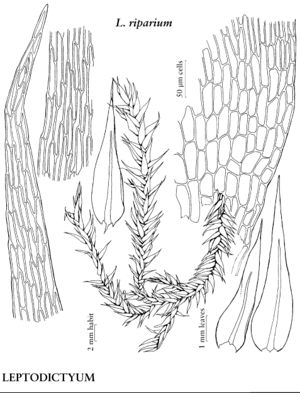Leptodictyum
Krypt.-Fl. Brandenburg 2: 867. 1906.
| Taxon | Illustrator ⠉ | |
|---|---|---|
 | Leptodictyum riparium | Patricia M. Eckel |
Plants medium-sized, green, yellow-green, or brown-green. Stems irregularly to sparingly branched; hyalodermis absent, central strand weakly developed; paraphyllia absent; rhizoids or rhizoid initials on stem or abaxial costa insertion, rarely forming tomentum, slightly branched, smooth; axillary hairs well developed and many, or small, delicate, sparse, distal cells hyaline when young. Stem and branch leaves erect to widespreading, not secund, oblong-lanceolate, not plicate, 2–6 mm; base not decurrent; margins plane, entire or obscurely serrulate, limbidia absent; apex acuminate, acumen plane; costa single, ending 3/5–3/4 leaf length; alar cells differentiated or not, rectangular, enlarged, walls thin, region gradually delimited, not extending up leaf; medial laminal cells linear, 42–117 µm; marginal cells 1-stratose. Sexual condition autoicous. Capsule inclined to horizontal, cylindric, curved; peristome perfect; exostome teeth bordered; endostome cilia 1–4, nodulose. Spores 10–19 µm.
Distribution
Nearly worldwide
Discussion
Species 7 (2 in the flora).
L. Hedenäs (2003b) included in Leptodictyum only a single, variable species, L. riparium, with L. humile treated in Amblystegium. According to A. Vanderpoorten et al. (2001, 2002b), L. humile should be treated as a member of Hygroamblystegium. From a morphological point of view, there is a continuum between Hygroamblystegium humile and H. tenax, the only actual feature distinguishing the two being the length of the costa, which continuously varies from ceasing at mid leaf to percurrent. The most recent molecular analyses (Vanderpoorten, pers. comm.) suggest that L. riparium falls within a completely unrelated clade together with large Campylium species. Vanderpoorten et al. (2002b) suggested that L. riparium appears more closely related to Campyliadelphus chrysophyllus and Campylium stellatum than to species of Amblystegium. In Leptodictyum, the endostome segments are hyaline and filiform; the spores are minutely papillose.
Selected References
None.
Lower Taxa
Key
| 1 | Stems 6-20 cm, flaccid; basal laminal cell walls lax; alar regions differentiated. | Leptodictyum riparium |
| 1 | Stems 3-6 cm, stiff; basal laminal cell walls firm; alar regions not differentiated. | Leptodictyum wallacei |
"narrower" is not a number.